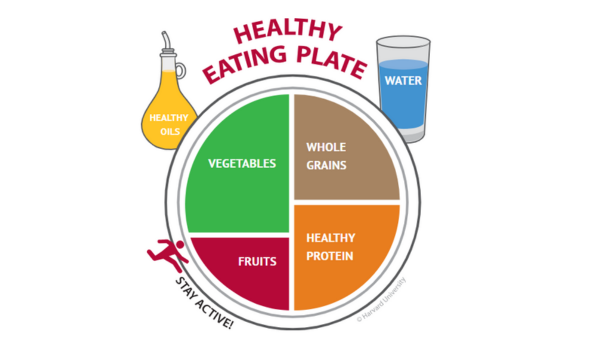
โภชนาการสำหรับนักมวย
พลังจากจานอาหาร: แนวทางโภชนาการนักมวยเพื่อชัยชนะ
กีฬามวยเป็นการต่อสู้ที่ต้องใช้ทั้งแรงระเบิด (power) และความทนทาน (endurance) ทำให้ร่างกายของนักมวยเผาผลาญพลังงานสูงและต้องการสารอาหารเฉพาะทาง การรับประทานอาหารที่เพียงพอและเหมาะสมจึงไม่ใช่แค่ “กินให้อิ่ม” แต่ต้องกินให้ พอดี–ถูกเวลา–ถูกชนิด เพื่อสนับสนุนการฝึกซ้อม ควบคุมน้ำหนัก และเพิ่มประสิทธิภาพในวันแข่งขัน แนวทางที่ได้รับการยอมรับในปัจจุบันคือการจัดโภชนาการตามรอบการฝึก (nutritional periodization) ซึ่งจะทำให้นักมวยใช้ศักยภาพทางร่างกายได้เต็มที่
พลังงานรวม
นักมวยควรได้รับพลังงานประมาณ 2,800–3,500 กิโลแคลอรี/วัน ขึ้นกับน้ำหนักตัวและความหนักของการฝึกซ้อม ในช่วงที่ต้องการลดน้ำหนักก่อนแข่งขัน สามารถปรับลดพลังงานได้ แต่ไม่ควรต่ำกว่า 2,000 กิโลแคลอรี/วัน เพื่อป้องกันการสูญเสียมวลกล้ามเนื้อ
ตัวอย่างเมนู: ข้าวกล้อง 2–3 ทัพพี อกไก่ย่าง 1 ชิ้นใหญ่ ไข่ต้ม 2 ฟอง ผัดผักน้ำมันน้อย กล้วยหอม 1–2 ลูก
คาร์โบไฮเดรต: แหล่งพลังงานหลัก
นักมวยควรได้รับ 5–7 กรัมต่อน้ำหนักตัว 1 กก.ต่อวัน เช่น น้ำหนัก 60 กก. = 300–400 กรัม/วัน ควรเลือกคาร์โบไฮเดรตเชิงซ้อน เช่น ข้าวกล้อง มันเทศ ขนมปังโฮลวีต และผลไม้
ก่อนซ้อม 3–4 ชม. รับประทานอาหารมื้อหลักที่มีคาร์โบไฮเดรต เช่น ข้าวหรือขนมปัง
ก่อนซ้อม 30–60 นาที เลือกคาร์โบไฮเดรตย่อยง่าย เช่น กล้วยหอม ขนมปังทาแยม
ตัวอย่างเมนู:
ข้าวสวย 2 ทัพพี + อกไก่ย่าง มันเทศต้ม 2 หัวเล็ก กล้วยหอม 1 ลูกก่อนขึ้นซ้อม
โปรตีน: ซ่อมแซมและสร้างกล้ามเนื้อ
ควรได้รับ 1.6–2 กรัมต่อน้ำหนักตัว 1 กก.ต่อวัน เช่น น้ำหนัก 60 กก. ควรบริโภคโปรตีน 100–120 กรัมต่อวัน และควรกระจายการบริโภคเป็น 4–5 มื้อ โดยเฉพาะหลังซ้อมภายใน 30 นาที ควรได้รับโปรตีนคุณภาพสูงเพื่อช่วยฟื้นฟูกล้ามเนื้อ ได้แก่เมนูที่ประกอบไปด้วยเนื้อ นม ไข่ ปลา
ไขมัน: พลังงานระยะยาว
ควรได้รับไขมัน 20–30% ของพลังงานรวมต่อวัน โดยเลือกไขมันที่ดี เช่น ปลาทะเล น้ำมันมะกอก ถั่วและเมล็ดพืช หลีกเลี่ยงอาหารทอดและการใช้น้ำมันซ้ำ
ตัวอย่างเมนู: ข้าวกล้อง + แกงส้มปลา + อะโวคาโด 3–4 ชิ้น ถั่วลิสงคั่วไม่ใส่เกลือ 1 กำมือ
วิตามินและเกลือแร่:
เป็นสารอาหารที่ร่างกายต้องการปริมาณไม่มาก แต่มีบทบาทสำคัญต่อสมรรถภาพ เช่น
ธาตุเหล็ก: พบในเนื้อแดง ไข่แดง → ช่วยสร้างเม็ดเลือด
แคลเซียม–วิตามินดี: พบในนม โยเกิร์ต ปลาเล็ก → เสริมความแข็งแรงของกระดูก
แมกนีเซียม–สังกะสี: พบในถั่ว เมล็ดพืช → ช่วยการฟื้นตัว
สารต้านอนุมูลอิสระ: ผัก–ผลไม้หลากสี → ลดการอักเสบและความเครียดออกซิเดชัน
ตัวอย่างเมนู: ข้าว + ไข่เจียวใส่ผักรวม + นม 1 แก้ว + ฝรั่ง 1 ลูก
น้ำและอิเล็คโตรไลท์
การให้น้ำเพียงพอเป็นสิ่งจำเป็น นักมวยควรดื่มน้ำวันละ 2.5–3.5 ลิตร และจิบน้ำทุก 15–20 นาทีระหว่างซ้อม (150–250 มล.) หากซ้อมหนักหรือในสภาพอากาศร้อน ควรเสริมเกลือแร่เพื่อชดเชยการสูญเสียทางเหงื่อ
แนวทางปฏิบัติ:
ดื่มน้ำ 500 มล. ก่อนซ้อม 2 ชม.
ระหว่างซ้อม: จิบน้ำหรือน้ำเกลือแร่
หลังซ้อม: ดื่มน้ำ 1 ลิตรภายใน 2 ชม.
โภชนาการตามช่วงเวลา (Periodization)
ช่วงฝึกทั่วไป: กินครบ 5 หมู่ เน้นข้าว–แป้งไม่ขัดสี และโปรตีนกระจายตลอดวัน
ช่วงฝึกเข้มข้น: เพิ่มคาร์โบไฮเดรตก่อนการซ้อม และโปรตีนทันทีหลังฝึกซ้อม
ช่วงคุมน้ำหนักก่อนแข่ง: ลดข้าว–แป้งลง แต่คงโปรตีนสูง และเพิ่มผักผลไม้
วันแข่งขัน:
มื้อก่อนแข่ง 3–4 ชม.: ข้าวต้มหมู + กล้วย + น้ำ
30–60 นาทีก่อนแข่ง: กล้วย/ขนมปัง
หลังแข่ง: น้ำ + เกลือแร่ + กล้วยหอม + นม
สรุป
โภชนาการที่ดีสำหรับนักมวยต้องประกอบด้วยคาร์โบไฮเดรต โปรตีน ไขมันดี วิตามิน–เกลือแร่ และน้ำ โดยปรับตามรอบการฝึกและช่วงก่อนแข่งขัน การวางแผนการกินอย่างเหมาะสมจะช่วยให้นักมวยฝึกซ้อมได้เต็มที่ ฟื้นตัวเร็ว คุมน้ำหนักอย่างมีประสิทธิภาพ และพร้อมชกได้อย่างเต็มศักยภาพ


Power from the Plate: Nutritional Guidelines for Muay Thai Fighters Toward Victory
Muay Thai is a combat sport that requires both explosive power and endurance, demanding a high rate of energy expenditure and precise nutrient intake. For Muay Thai practitioners, eating is not merely about “feeling full,” but about consuming food that is adequate, timely, and appropriate in composition to support training, manage body weight, and optimize performance on fight day.
The currently accepted principle is known as nutritional periodization, a strategy that aligns dietary intake with the athlete’s training phases to maximize physical potential.
Total Energy Intake
Muay Thai athletes should consume approximately 2,800–3,500 kilocalories per day, depending on body weight and training intensity.
During weight reduction phases prior to a match, caloric intake can be slightly decreased but should not fall below 2,000 kilocalories per day to prevent muscle mass loss.
Sample Meal:
Brown rice (2–3 servings), grilled chicken breast (1 large piece), boiled eggs (2), stir-fried vegetables with minimal oil, and 1–2 bananas.
Carbohydrates: The Primary Energy Source
Carbohydrates are the body’s main energy substrate. Muay Thai fighters should consume 5–7 grams of carbohydrates per kilogram of body weight per day.
For instance, a 60-kg athlete should consume approximately 300–400 grams daily. Complex carbohydrates are preferred, such as brown rice, sweet potatoes, whole-grain bread, and fruits.
Timing Recommendations:
- 3–4 hours before training: Consume a carbohydrate-rich main meal (e.g., rice or bread).
- 30–60 minutes before training: Choose easily digestible carbohydrates such as bananas or bread with jam.
Sample Menu:
Steamed rice (2 servings), grilled chicken breast, boiled sweet potatoes (2 small), and 1 banana before training.
Protein: Muscle Repair and Synthesis
Protein is essential for muscle repair, recovery, and hypertrophy. Muay Thai fighters should consume 1.6–2.0 grams of protein per kilogram of body weight per day.
For a 60-kg athlete, this equals 100–120 grams daily, divided across 4–5 meals.
High-quality protein should be consumed within 30 minutes after training to support muscle recovery.
Recommended Sources:
Lean meat, fish, eggs, and dairy products such as milk and yogurt.
Fat: Sustained Energy Source
Healthy fats should constitute 20–30% of total daily energy intake.
Opt for sources of unsaturated fats such as oily fish, olive oil, nuts, and seeds, while avoiding deep-fried foods and reused oils.
Sample Menu:
Brown rice with sour curry and fish, avocado slices (3–4 pieces), and a handful of unsalted roasted peanuts.
Vitamins and Minerals: Micronutrients for Performance
Though required in small quantities, vitamins and minerals play critical roles in maintaining physiological functions and athletic performance:
- Iron: Found in red meat and egg yolk — supports red blood cell formation and oxygen transport.
- Calcium & Vitamin D: Found in milk, yogurt, and small fish — essential for bone strength.
- Magnesium & Zinc: Found in nuts and seeds — aid in muscle recovery and immune function.
- Antioxidants: Found in colorful fruits and vegetables — help reduce inflammation and oxidative stress.
Sample Menu:
Steamed rice, vegetable omelet, a glass of milk, and one guava.
Hydration and Electrolyte Balance
Proper hydration is vital to sustain performance and prevent heat-related fatigue.
Muay Thai athletes should drink 2.5–3.5 liters of water daily and sip 150–250 ml every 15–20 minutes during training.
In high-intensity or hot environments, electrolyte replacement is recommended to compensate for sweat loss.
Hydration Protocol:
- 2 hours before training: Drink 500 ml of water.
- During training: Sip water or electrolyte drinks regularly.
- After training: Rehydrate with at least 1 liter of water within 2 hours.
Nutritional Periodization
- General Training Phase: Consume a well-balanced diet emphasizing whole grains and distributed protein intake throughout the day.
- Intensive Training Phase: Increase carbohydrate intake before sessions and consume protein immediately afterward.
- Pre-fight Weight Control Phase: Reduce carbohydrate portions but maintain high protein intake and emphasize fruits and vegetables.
On Fight Day:
- 3–4 hours before the bout: Rice porridge with pork, banana, and water.
- 30–60 minutes before the bout: Banana or bread.
- Post-fight: Water, electrolyte drink, banana, and milk for rehydration and recovery.
Conclusion
Optimal nutrition for Muay Thai fighters comprises balanced intake of carbohydrates, proteins, healthy fats, vitamins, minerals, and water, all tailored to training cycles and pre-fight periods.
Strategic meal planning not only enhances training performance and recovery efficiency, but also supports effective weight management and ensures readiness for peak performance in the ring (เวทีมวย).
